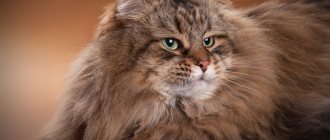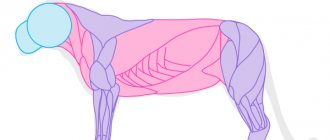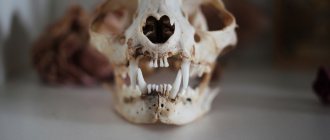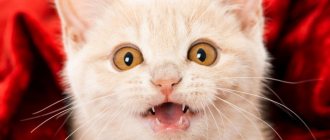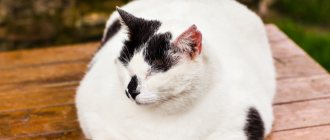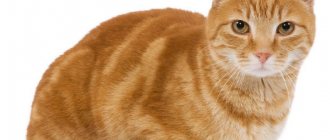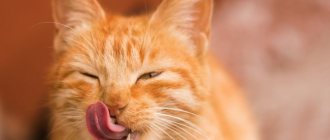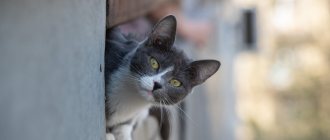5897Administration
Cats are very active, move a lot and are constantly near people, vigilantly monitoring the activities of their owners. All this also requires a lot of energy and strength. And the cat’s heart copes with the function of saturating the body with oxygen and energy.
What is the function of a cat's heart? What is its structure? What is the most common disease in a cat?
© shutterstock
Function and principle of action of the heart
The heart is an internal pump, a muscle that pumps blood, supplying the cat’s body with oxygen and nutrients and removing carbon dioxide from the organs. In this case, one side of the heart, the right, pumps blood only to the lungs. The left one pumps blood to the rest of the cat’s body organs.
Interesting information about cat blood. It turns out that the formula and composition of a cat’s blood does not correspond to any other animal. Blood clots very quickly and its reaction to some chemicals is unique (this point is still being studied). But that's not all. Scientists have found that the composition of the blood of each cat is different, just like that of humans. There is a certain system that divides blood into groups. This is all that the researchers have found out so far.
The essence of the heart's action is to force blood to move through the cat's body. The heart pumps blood into the lungs. There it is enriched with oxygen and returned to the muscle.
Then it is sent through the vessels throughout the body, and some of it seeps into the tissues and collects in the lymphatic system. In this system, the blood is purified by passing through the glands and receives a certain number of lymphocytes. And all this movement is driven by the heart pump. It’s worth getting acquainted with the structure of this pump and finding out what the structure of a cat’s heart is.
© shutterstock
Causes
Epilepsy attacks in cats do not have a breed or gender predisposition. But statistically, more cases are registered in exotic animals, where a modification of the skull is observed, and cats suffer from this pathology more often than females. There is no explanation for this - just statistics. The disease can be transmitted genetically, but not necessarily directly from one generation to another, maybe through a generation or two.
The most important causes of epilepsy are disturbances in the conduction activity of nerve impulses in the brain. They are acquired during life, or cats are born with them. Various additional factors act as provocations of attacks. These factors are cerebral (structural pathologies of the brain) and extracerebral (toxic effects on the brain without primary changes in its structures).
- Structural changes in the brain: vascular pathologies, hemorrhages, inflammatory processes with edema, trauma, neoplasms, etc.
- External factors: poisons and toxins, hypoxia (oxygen starvation), jumps or drops in blood enzyme levels, etc.
Anatomy of the heart
The structure of the cat's heart muscle looks the same as in birds, and in humans, and in any mammal, it consists of 4 parts, chambers:
- The upper chambers are called the left and right atria.
- Next comes the middle layer. This muscle is called the myocardium.
- The lower hollow chambers are the ventricles.
Blood moves through the body due to the contraction of the ventricles.
What is the size of a cat's heart? It is believed that while the anatomy of the structure and arrangement of organs is similar to other animals, the cat’s heart is small. Depending on the breed and age, we can say that it occupies only 2 intercostal spaces - this is a very small size. And the heart doesn’t look special or big from the outside; it weighs from 12 to 15 grams.
If the cat’s body is healthy, it has a sufficient amount of hormones and everything is normal with the autonomic system, then this affects the main organ, and the cat will not have heart problems. The rhythm, the force with which the heart muscle contracts and the frequency of contractions, the work of the vascular system, its contraction and expansion, all depend on whether the cat has certain problems or hormonal heart disease.
How do you know if there is a disease in the heart itself? Several factors may indicate this. For example, a cat’s weight exceeds the norm. A symptom may also be that the cat is tired, or that after intense games her heart almost jumps out of her chest. This, if not a sign of the disease itself, is a reason to start worrying and start checking.
Normal organ sizes
The size and weight of the heart are not constant and depend on many factors:
- The age of the pet plays a big role (in old dogs the organ often becomes flabby and enlarges).
- Floor. In males, the mass of the organ is up to 20% greater than in females.
- Animal fatness.
- Physical activity. Service dogs and hunting dogs regularly used for their intended purpose have a noticeably larger heart.
It is also known that in the embryonic state this organ (relative to body weight) is simply huge. This is easily explained by the fact that at the stage of fetal maturation, the puppy’s heart pumps blood not only throughout its own body, but also through the placental network.
Cat heart disease
What do pet owners need to know about what heart problems there are in cats and how to recognize them? Most often, furry owners encounter a problem such as cardiomyopathy; the causes of the disease are different, and therefore there are several varieties :
- Hypertrophic;
- Dilation;
- Restrictive;
- Intermediate.
© shutterstock
Cardimopathy
Among all disorders of the heart, cardiomyopathy is most often diagnosed in cats of various age groups and breeds. Pathology caused by structural abnormalities in the muscular structures of a hollow organ inevitably leads to disruption and dysfunction of the pumping system. In severe cases, congestive heart failure develops, which will lead to anemia and oxygen starvation.
Due to the accumulation of fluid in the pulmonary circulation, respiratory distress syndrome develops. Leads to the formation of blood clots that clog blood vessels. In cats, edema, paralysis, paresis of the hind limbs, acute anemia, and fainting are noted. If treatment is not started in time, the disease is fatal in 100% of cases.
Most cardiopathies in animals are of primary origin. The secondary form of the disease develops rarely and can be caused by surges in blood pressure, anemia, and hyperthyroidism.
In veterinary medicine, there are four types of primary cardiomyopathies in cats:
- Hypertrophic. Characterized by thickening of the myocardium, increased pressure in the cavities of the heart. Leads to the development of acute heart failure.
- Restrictive. With this pathology, there is a loss of elasticity of the myocardium, which leads to degeneration of organ tissue. The systolic and diastolic function of the heart muscle is impaired.
- Dilatational. Characterized by thinning and stretching of the heart walls. The heart enlarges and its contractile function is impaired.
- Arrhythmogenic. A rare genetically determined disease characterized by the replacement of normal tissues with fibrofatty tissue. The pathological process mainly involves the right ventricle.
Each disease has its own specific symptoms and manifestations. Some diseases have a genetic, hereditary origin. Thus, hypertrophic cardiomyopathy is most often noted in Sphynx cats, Norwegian Forest cats, British cats, Maine Coons, Siamese, Abyssinian cats, as well as Redgall and Scottish Fold breeds.
Symptoms
Behavior changes in cats with cardiomyopathy. The condition may be stable until the pathology reaches a critical stage. The disease is manifested by weakness, drowsiness, breathing problems, and unstable temperature. Pulse and blood pressure changes.
Sharp changes in emotional state are noted. Bouts of calm are replaced by increased excitability. Cats meow pitifully, demanding the attention of their owners, hiding in secluded places.
Treatment
Treatment of cardiomyopathies in cats depends on the form and severity of the disease and is most effective at an early stage of development. Therapy is selected individually, in each specific case.
Used in treatment:
- beta blockers;
- medications to prevent thromboembolism;
- blood thinners;
- diuretics;
- calcium channel blocking drugs;
- vitamins;
- homeopathy.
If cardiomyopathy of any form and etiology is detected, the animals, despite their breed qualities, are removed from breeding.
Good to know
- Can cats hide pain?
- Serval cats
- Urinary retention in cats
- Causes of pain syndrome in cats
- Feline Orofacial Pain Syndrome
- Catnip for cats
- How to care for an old cat?
- How to properly dry a cat?
- How to Choose a Kitten for your Home
- Pneumonia of Cats
- Causes of Sneezing in Cats
- Anatomy and physiology of the liver in cats
- The structure and functions of the thyroid gland in cats
- Measuring blood pressure in cats
- Current role of dexmedetomidine in clinical veterinary and medical anesthesia and intensive care
- Thyroid function testing in cats
- Gabapentin in cats and dogs
- Information content of hematological and echocardiographic preoperative screening indicators
- Historical background on hyperthyroidism in cats
- Hyperthyroidism in older cats
- Cardiac hypertrophy in cats
- Analysis of anamnestic data during preoperative examination of animals
- Study of anamnestic data in cats before general anesthesia
- Method for measuring blood pressure in cats
- ICD in cats (diagnosis and symptoms)
- Hyperthyroidism is suspected, but serum T4 concentration is normal
- Acute gastroenterocolitis in dogs (etiology, pathogenesis, diagnosis and treatment)
- Reducing mortality during anesthesia is an important task of veterinary anesthesiology
- Thrombosis in cats (general information, etiology, pathogenesis, clinical picture, diagnosis and treatment)
- Urolithiasis of small animals (etiology, pathogenesis, diagnosis and treatment)
- Congestive cardiomyopathy in cats (What is it? How to protect your pets)
- Gastrointestinal tract in dogs (anatomy and physiology)
Alarming symptoms
Normally, the anatomy of a cat's heart is not very different from a human's, except for the size of the organ, and it consists of 4 chambers. The pet's internal organ is located above the ulnar tubercle. Owners are not always able to recognize heart pathologies on time, since many diseases do not show any clinical picture for a long time.
With myocardial disease, the animal is forced to stick out its tongue while breathing.
Most heart pathologies are characterized by the following symptoms:
- decreased motor activity;
- lethargic and apathetic state;
- constant desire to sleep;
- rapid breathing, in which the cat takes more than 40 breaths per minute;
- shortness of breath not provoked by physical activity;
- protruding tongue when breathing;
- problems with appetite;
- pale and blue visible mucous membranes;
- tachycardia, in which the heart beats rapidly.


